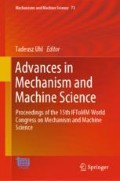Abstract
Tensegrity structures are a new trend in the soft robotics field, especially for aerospace applications. However, many other applications, such as biomechanics, have not made full use of the advantages that this kind of structure presents yet. In this paper, we present a robotic joint based on a two-stage tensegrity structure. Using a marching procedure to find new stable positions, the control method calculates the required steps and actuates some of the cables until this new position is achieved. Preliminary experiments show that the structure can attain bending of 20° and maintain the equilibrium. This prototype shows that tensegrity structures can be effectively used for positioning in three dimensions.
Access this chapter
Tax calculation will be finalised at checkout
Purchases are for personal use only
Preview
Unable to display preview. Download preview PDF.
References
Motro, R.: Tensegrity: Structural Systems for the Future. 1st edn. Kogan Page Science, London (2003).
Ingber, D.: Tensegrity I. Cell structure and hierarchical systems biology. Journal of Cell Science (11), 1157-1173 (2003).
Castro Arenas, C., Ghersi, I., Miralles, M.: Biomechanics and Biotensegrity: Study Method and Frequency Response of the Simplex and 3-bar-SVD Tensegrity Configurations. Journal of Physics: Conference Series (705), 1-10 (2016).
Silva, P., Fonseca, S., Turvey, M.: Is tensegrity the functional architecture of the equilibrium point hypothesis? Motor Control (14), 35-40 (2010).
Scarr, G.: A consideration of the elbow as a tensegrity. International Journal of Osteopathic Medicine (15), 53-65 (2012).
Tibert, G.: Deployable tensegrity structures for space applications. Ph.D. dissertation, Department of Mechanics, Royal Institute of Technology, Stockholm (2002).
Zolesi, V. S., Ganga, P. L, Scolamiero, L., Micheletti, A., Podio-Guidugli, P., Tibert, G. et al. On an innovative deployment concept for large space structures. In: 42nd International Conference on Environmental Systems, San Diego (2012).
Tibert, G., Pellegrino, S. Deployable tensegrity reflectors for small satellites. Journal of Spacecraft and Rockets (39), 701-709 (2002).
Rhode-Barbarigos, L.: An active deployable tensegrity structure. Ph.D. dissertation, Faculty of Natural Environment, Architecture and Construction, École Polytechnique Fédérale de Lausanne, Lausanne, Switzerland (2012).
Caluwaerts, K., Despraz, J., Iscen, A., Sabelhaus, A., Bruce, J., Schrauwen, B., et al.: Design and control of compliant tensegrity robots through simulation and hardware valida-tion. Journal of the Royal Society Interface (11), (2014).
Koizumi, Y., Shibata, M., Hirai, S. Rolling Tensegrity Driven by Pneumatic Soft Actuators. In: IEEE International Conference on Robotics and Automation, pp. 1988-1993. Minnesota (2012).
Ushigome, Y., Niiyama, R., Nishimura, K., Tanikawa, T., Hirose, M. Archi/e machina: Interactive architecture based on tensegrity. In: 16th International Conference on Virtual Systems and Multimedia, pp. 55-62. Seoul, Korea (2010).
Baltaxe-Admony, L., Robbins, A., Jung, E., Lessard, S., Teodorescu, M., SunSpiral, V., et al. Simulating the human shoulder through active tensegrity structures. In: Proc. ASME Int. Design Eng. Tech. Conf., Charlotte (2016).
Micheletti, A., Williams, W.: A marching procedure for form-finding for tensegrity structures. Journal of Mechanics of Materials and Structures (2), 857-882 (2007).
Skelton, R., De Oliveira, M.: Tensegrity Systems. 1st edn. Springer, New York (2009).
Sabelhaus, A., Bruce, J., Caluwaerts, K., Chen, Y., Lu, D., Liu, Y., et al. Hardware design and testing of SUPERball, a modular tensegrity robot. In: 6th World Conference of the International Association for Structural Control and Monitoring, Barcelona (2014).
Sultan, C.: Tensegrity deployment using infinitesimal mechanisms. International Journal of Solids and Structures (51), 3653-3668 (2014).
Robbin, J., Salamon, D.: Introduction to differential geometry. ETH Zurich, Zurich (2018).
Shampine, L., Gladwell, I., Thompson, S.: Solving ODEs with Matlab. Cambridge University Press, New York (2003).
McCauley, M. (2018). AccelStepper: AccelStepper library for Arduino, http://www.airspayce.com/mikem/arduino/AccelStepper/, last accessed 2018/06/05.
Zhang, J., Guest, S., Ohsaki, M.: Symmetric prismatic tensegrity structures: Part I. Configuration and stability. International Journal of Solids and Structures (46), 1-14 (2009).
Acknowledgements
This paper is funded by the International Exchange Program of Harbin Engineering University for Innovation-Oriented Talents Cultivation and National Natural Science Foundation of China (NSFC) 51605111, 51675114.
Author information
Authors and Affiliations
Corresponding author
Editor information
Editors and Affiliations
Rights and permissions
Copyright information
© 2019 Springer Nature Switzerland AG
About this paper
Cite this paper
González, A., Luo, A. (2019). Design and Control of a Tensegrity-Based Robotic Joint. In: Uhl, T. (eds) Advances in Mechanism and Machine Science. IFToMM WC 2019. Mechanisms and Machine Science, vol 73. Springer, Cham. https://doi.org/10.1007/978-3-030-20131-9_260
Download citation
DOI: https://doi.org/10.1007/978-3-030-20131-9_260
Published:
Publisher Name: Springer, Cham
Print ISBN: 978-3-030-20130-2
Online ISBN: 978-3-030-20131-9
eBook Packages: Intelligent Technologies and RoboticsIntelligent Technologies and Robotics (R0)

